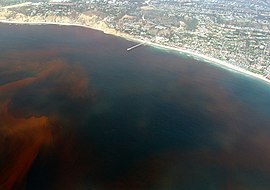
| Part of a series on |
| Plankton |
|---|
 |
Thin layers are concentrated aggregations of phytoplankton and zooplankton in coastal and offshore waters that are vertically compressed to thicknesses ranging from several centimeters up to a few meters and are horizontally extensive, sometimes for kilometers. Generally, thin layers have three basic criteria: 1) they must be horizontally and temporally persistent; 2) they must not exceed a critical threshold of vertical thickness; and 3) they must exceed a critical threshold of maximum concentration. The precise values for critical thresholds of thin layers has been debated for a long time due to the vast diversity of plankton, instrumentation, and environmental conditions.[1] Thin layers have distinct biological, chemical, optical, and acoustical signatures which are difficult to measure with traditional sampling techniques such as nets and bottles. However, there has been a surge in studies of thin layers within the past two decades due to major advances in technology and instrumentation. Phytoplankton are often measured by optical instruments that can detect fluorescence such as LIDAR, and zooplankton are often measured by acoustic instruments that can detect acoustic backscattering such as ABS.[2] These extraordinary concentrations of plankton have important implications for many aspects of marine ecology (e.g., phytoplankton growth dynamics, zooplankton grazing, behaviour, environmental effects, harmful algal blooms), as well as for ocean optics and acoustics. Zooplankton thin layers are often found slightly under phytoplankton layers because many feed on them. Thin layers occur in a wide variety of ocean environments, including estuaries, coastal shelves, fjords, bays, and the open ocean, and they are often associated with some form of vertical structure in the water column, such as pycnoclines, and in zones of reduced flow.[3]
- ^ Durham, William M.; Stocker, Roman (2012-01-15). "Thin Phytoplankton Layers: Characteristics, Mechanisms, and Consequences". Annual Review of Marine Science. 4 (1): 177–207. Bibcode:2012ARMS....4..177D. doi:10.1146/annurev-marine-120710-100957. ISSN 1941-1405. PMID 22457973.
- ^ Benoit-Bird, Kelly J.; Shroyer, Emily L.; McManus, Margaret A. (2013-08-02). "A critical scale in plankton aggregations across coastal ecosystems". Geophysical Research Letters. 40 (15): 3968–3974. Bibcode:2013GeoRL..40.3968B. doi:10.1002/grl.50747. ISSN 0094-8276. S2CID 16586461.
- ^ McManus, M. A., Cheriton, O. M., Drake, P. J., Holliday, D. V., Storlazzi, C. D., Donaghay, P. L., et al. (2005). Effects of physical processes on structure and transport of thin zooplankton layers in the coastal ocean. Marine Ecology Progress Series, 301, 199-215.
